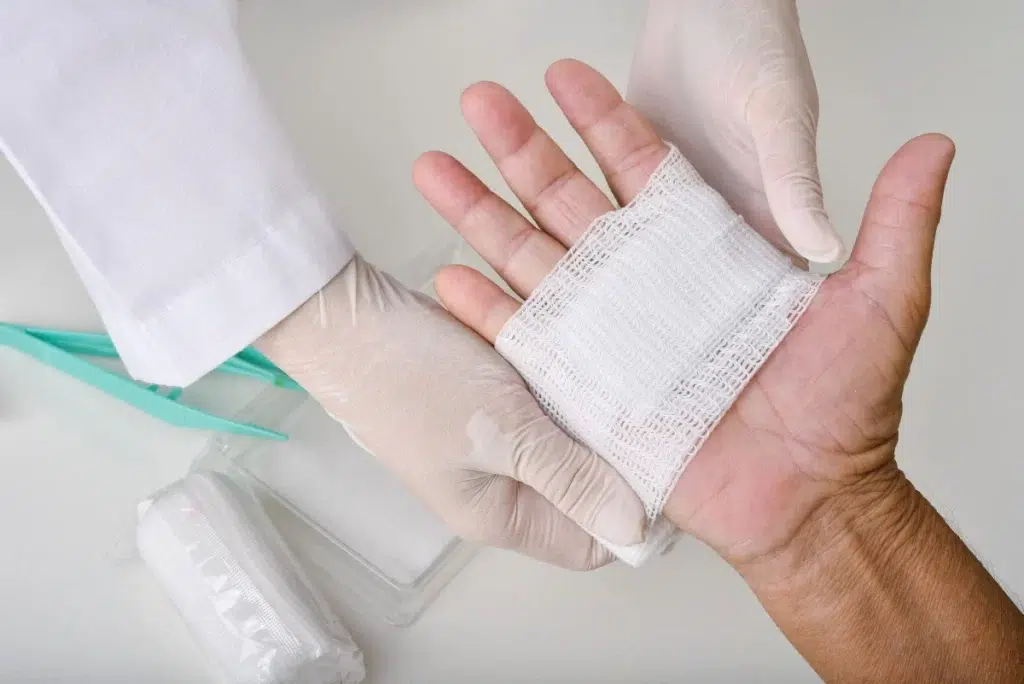What Is Wound Management?
Wound management entails caring for and treating various types of wounds to promote healing, prevent infection, and minimise complications. The process includes assessing the wound, cleaning and dressing it, and providing appropriate medical interventions when necessary.
The primary goal of wound management is to create an optimal environment for the body’s natural healing mechanisms, leading to the regeneration of damaged tissues and the closure of the wound.
Wounds can be managed through proper wound management techniques. Minor wounds, such as cuts, abrasions, and small burns, can typically be managed with simple first-aid measures. Chronic wounds, like pressure ulcers and venous ulcers, can benefit from specialised wound management. More complex injuries, such as surgical incisions, can be successfully managed through professional wound care techniques or advanced wound closure methods.
Effective wound management requires an assessment and collaborative approach between teams. The key to positive outcomes is equipping team members with the necessary knowledge, skills, and resources to conduct comprehensive wound assessments. By doing so, individuals can be provided with the best possible support to promote healing and minimise the risk of further complications.
Meaning of Wound Care
Wound care refers to specialised medical attention and treatments provided to promote the healing and recovery of wounds.
Healthcare professionals have the expertise to assess and manage wounds, providing personalised treatment plans to address an individual’s unique needs. By entrusting wound care to qualified professionals, individuals increase the chances of a successful healing process and minimise the risk of complications.
It is vital to identify the contributing factors influencing the wound, whether local or systemic. This knowledge helps in tailoring the treatment plan accordingly. Also, a thorough examination of the individual’s medical history and a physical assessment are obligatory. These steps provide valuable insights into the wound’s characteristics, enabling healthcare professionals to make informed decisions about the most appropriate course of action.

Implementation of suitable wound care techniques is crucial. Careful selection of dressings and treatment methods is essential in optimising wound healing and promoting positive outcomes.
Lastly, regular monitoring of the wound’s healing progress is vital. Should there be a lack of improvement, it is imperative to reassess the wound care plan and make necessary adjustments. By consistently following these steps and providing meticulous attention to wound management, healthcare professionals can facilitate healing and improve individual outcomes.
7 Steps of Wound Care
Wounds should always be assessed and monitored by healthcare teams for possible complications. Minor wounds can be treated at home, while more substantial wounds need to be assessed by healthcare professionals. By treating wounds immediately, individuals can improve their recovery.
From identifying contributing factors to selecting suitable treatments, monitoring progress, and making necessary adjustments, the 7 steps of wound care help healthcare providers address the unique needs of each wound. The steps of wound care provide a structured framework that improves the consistency and quality of wound management, leading to better outcomes, reduced complications, and an overall enhanced healing process for individuals with wounds.
Step 1: Wash Hands
All wounds must be prevented from infection. Therefore, the first step to assessing the wound is to wash your hands, even if they appear clean.
Before doing anything to a wound, the hands must be washed thoroughly under water for at least 20 seconds. Using soap to remove germs and bacteria that may cause infection in a wound is vital. Applying hand sanitiser afterwards is recommended.
Step 2: Stop the Bleeding
The next step in wound care is to stop any bleeding from the wound. This requires applying pressure to the wound, which allows the blood to clot. A clean cloth or bandage should be used to avoid infection.
It’s recommended to raise the wound above the heart. This reduces blood flow and prevents blood from rushing to the wound site, which will help stop the bleeding.
Step 3: Clean the Wound
Once bleeding has stopped, the next step is to clean the wound with running water for at least five minutes. Using soap around the wound but avoiding applying it inside it is crucial. The purpose of cleaning is to create an environment for wound healing.
Afterwards, dry the wound with a clean cloth. If there is debris or foreign material within the wound, seeking medical advice is essential to prevent infection.
Step 4: Apply Antibacterial Ointment
If the wound is minor, applying antibacterial ointment to prevent an infection is recommended. This action prevents the growth of bacteria that may lead to an infection. However, if the wound is not minor, medical professionals should take care of this step.
Step 5: Protect the Wound
The next step of wound care is to cover the wound with a sterile dressing and secure it with a plaster or medical dressing. The dressing should be tight enough over the wound so it doesn’t slip off. Proper wound dressing shields the skin from external factors and potential infections.
Step 6: Change the Dressing
Consistently changing the dressing at least once a day is recommended. Before each dressing change, the hands should be washed thoroughly, the wound carefully cleaned, and the sterile bandage secured. During this step of the healing process, an individual must evaluate the wound and consult with a doctor if there are signs that the wound healing is delayed.
Step 7: Observe Symptoms
It is crucial to monitor the wound for signs of infection throughout the healing process. Be vigilant and watch out for symptoms such as:
- Redness
- Severe pain
- Swelling
- Unusual odour
- Sores/blisters
- Fever
- Thick and yellowish discharge
- Darkening of the skin around the wound
If you notice any of these symptoms and signs, consult a general practitioner (GP), who can assess the wound and provide appropriate care.
Why Is Wound Care a Critical Part of Recovery?
Wound care plays a vital role in individuals’ physical and emotional recovery. When the wound is appropriately treated, the healing process can begin. If wounds are not treated appropriately, it can cause major infections and worsen the wound.
Effective wound care also plays a crucial role in preventing further damage or complications. Without proper care, wounds can become infected, leading to delayed healing, increased pain, and potential systemic infections.
By implementing appropriate wound care techniques, healthcare providers can mitigate these risks, prevent infections and speed up recovery, resulting in less severe scars. Additionally, wound care allows for regular monitoring of the wound’s progress, enabling healthcare professionals to detect any signs that may require necessary adjustments to the treatment plan.
The Importance of Effective Wound Care
Effective wound care plays a vital role in promoting faster healing, facilitating better recovery, and providing the necessary protection for the wound. Neglecting proper wound care can lead to the development of chronic wounds, resulting in additional complications and prolonged pain.
Tailoring wound care to the individual’s specific needs is crucial. Treatment plans should be carefully designed to address these unique requirements while also prioritising speedy and comprehensive healing. In addition, effective wound care encompasses clear communication and adequate education. Healthcare professionals empower individuals and their families by equipping them with a sustainable, self-sufficient care routine that can be easily followed.
By emphasising the significance of effective wound care, we aim to maximise healing outcomes, minimise complications, and enhance overall well-being.

Importance of Frequent Wound Dressing
Regular dressing changes help to maintain a clean and sterile environment around the wound. This significantly reduces the risk of complications and promotes a faster healing process.
Also, frequent wound dressing allows healthcare professionals to closely monitor the progress of the wound. During each dressing change, they can assess the healing status, evaluate any changes in the wound’s appearance, and identify potential signs of infection or other complications. This ongoing assessment is crucial for making informed decisions regarding the course of treatment. By identifying any issues early on, healthcare providers can take appropriate measures to address them promptly, optimising the healing.
Our teams at Leaf Complex Care are experts in wound management and can help individuals on their recovery journey by providing proactive and compassionate support.
Wound Management Goals
As each wound is different, the wound management goals of each wound will follow a different structure.
With that said, there are some key factors within wound management:
Prevent bleeding – Effectively controlling and minimising bleeding is crucial in the early stages of wound management.
Clean debris and prevent infection – Thoroughly removing any debris from the wound and maintaining a sterile environment is essential to prevent infections.
Protect the wound – Applying appropriate dressings and protective measures safeguards the wound from external contaminants and further damage.
Promote tissue – Encouraging the growth and regeneration of healthy tissue is a fundamental goal in wound management.
Protect new epithelial tissue and monitor the area – Careful monitoring of the wound’s progress and protecting newly formed tissue is necessary to ensure optimal healing.
Healthcare professionals and GPs should always be consulted when wounds are substantial or painful. Their expertise and guidance will help ensure the most effective management of wounds, promoting optimal healing outcomes and addressing any potential complications.
Wound Management at Your Home
At Leaf Complex Care, we understand the importance of wound recovery. Our team of support workers are experts in wound management and provide proactive wound management in the comfort of your own home.
Our care plans are always tailored to each individual we serve and their unique health needs, aspirations and preferences. We promote independence, and our compassionate team are committed to your recovery.
If you or your loved one need more information regarding our wound care services, contact us today, or visit our offices in Bristol, Exeter, South East, Somerset and the Midlands.

